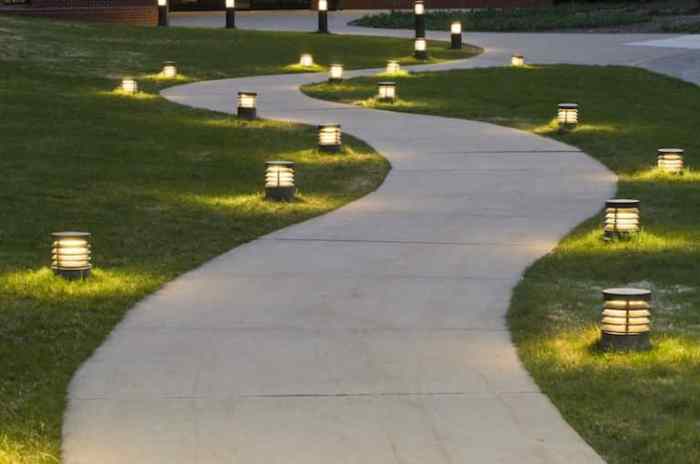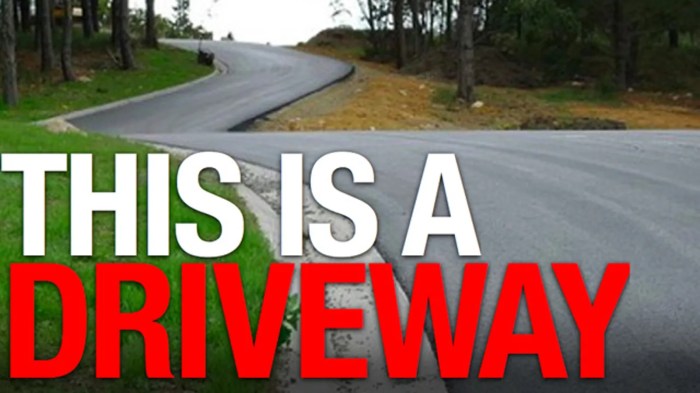Driveway Pathways Design, Build, and Maintain
Driveway pathways are more than just a route to your front door; they’re a crucial design element that impacts curb appeal, property value, and daily convenience. Choosing the right materials, considering the landscape, and planning for long-term maintenance are all key factors in creating a driveway that’s both beautiful and functional. This guide will walk you through every step, from initial design concepts to choosing the perfect materials and handling repairs, ensuring your driveway is a source of pride for years to come.
We’ll explore various pathway materials, like concrete, asphalt, gravel, pavers, and brick, comparing their durability, maintenance needs, and aesthetic qualities. We’ll also delve into design considerations such as property size, landscaping, and drainage, offering practical advice and illustrative examples to inspire your driveway project. Finally, we’ll cover construction, installation, maintenance, budgeting, safety features, and even the environmental impact of your choices, equipping you with the comprehensive knowledge needed to make informed decisions.
Types of Driveway Pathways
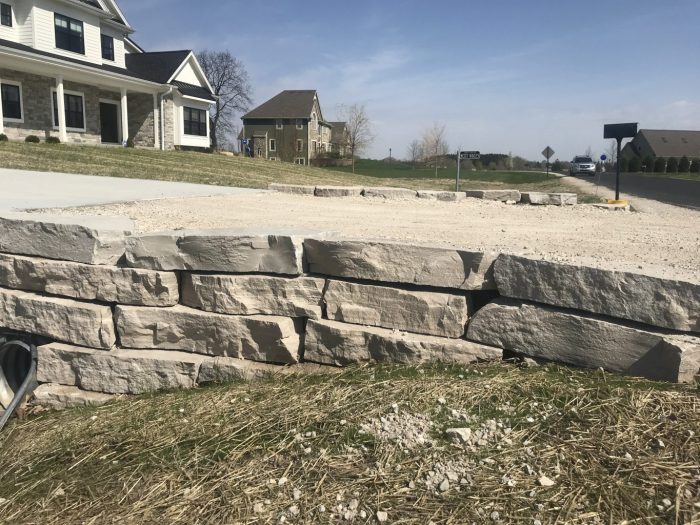
Source: willowtreelandscapesolutions.com
Choosing the right driveway material is a crucial decision that impacts both the aesthetics and functionality of your home. The material you select will significantly influence the longevity, maintenance needs, and overall cost of your driveway. Let’s explore some popular options.
Driveway Material Comparisons
This section compares common driveway materials based on durability, maintenance requirements, and aesthetic appeal. Understanding these factors will help you make an informed decision.
| Material | Durability | Maintenance | Aesthetic Description |
|---|---|---|---|
| Concrete | High; durable and long-lasting, resistant to most weather conditions. Can crack under extreme temperature fluctuations or heavy loads. | Relatively low; occasional crack sealing and cleaning. | Can be poured in a variety of colors and textures. Smooth finishes offer a clean, modern look, while stamped concrete can mimic the appearance of brick or stone. Color options range from classic gray to vibrant reds and browns. |
| Asphalt | Moderate; less durable than concrete, susceptible to cracking and potholes, especially in freeze-thaw cycles. Proper installation is key to longevity. | Moderate; requires periodic sealing to prevent water damage and cracking. Pothole repairs may be needed over time. | Typically dark gray or black, offering a smooth, uniform surface. Can be textured to improve traction. Its dark color can absorb significant heat in sunny climates. |
| Gravel | Low; susceptible to shifting and erosion, especially in wet conditions. Requires regular replenishment. | High; frequent raking and replenishment are needed to maintain a level surface and prevent weed growth. | Offers a natural, rustic look. Comes in various colors and sizes, allowing for customization. The texture is naturally rough and uneven. |
| Pavers (Brick, Stone, etc.) | High; individual pavers can be replaced if damaged, making repairs relatively easy. Durable and long-lasting if properly installed. | Moderate; occasional weeding and cleaning between pavers. Requires periodic resealing to prevent staining. | Offers a wide range of aesthetic options. Brick pavers provide a classic, traditional look, while stone pavers offer a more natural, rugged appearance. Colors and patterns are highly customizable. The texture varies greatly depending on the type of paver. |
Driveway Pathway Design Considerations
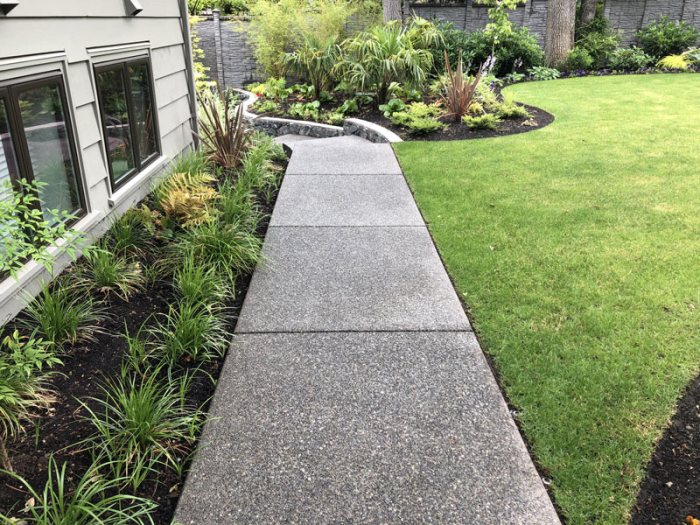
Source: vistamasonry.com
Designing a driveway pathway involves more than just choosing a material; it’s about seamlessly integrating functionality and aesthetics into your property’s overall design. Several key factors must be considered to ensure your driveway is both beautiful and practical. Ignoring these factors can lead to costly repairs or a less-than-ideal outcome.
Property Size, Landscaping, and Architectural Style
The size of your property significantly impacts driveway design. A large property allows for longer, more elaborate driveways, potentially incorporating curves and landscaping features. Smaller properties often necessitate more compact, straight designs to maximize usable space. Landscaping should complement the driveway, not compete with it. Consider the existing plants, trees, and other features, and plan the driveway’s path to enhance, rather than obstruct, their visual appeal. Finally, the driveway’s architectural style should harmonize with the style of your home and other buildings on the property. A modern home might suit a sleek, minimalist driveway, while a traditional home might benefit from a more classic, curving design.
Slope and Drainage
Proper slope and drainage are crucial for preventing water damage and erosion. A slight slope away from the house is essential to direct water runoff and prevent it from accumulating near the foundation. This prevents water damage to the house and the driveway itself. The slope should be gradual and consistent to avoid creating uneven surfaces or pooling water. Adequate drainage systems, such as gravel or French drains, may be necessary in areas with heavy rainfall or poor soil drainage. Ignoring proper drainage can lead to significant problems over time, including driveway cracking, foundation settling, and landscaping damage.
Driveway Pathway Layout Examples
The following examples illustrate how driveway design adapts to different property sizes and landscaping features.
- Design 1: Large Property with Mature Trees
- A long, gently curving driveway that winds through a grove of mature trees. This design maximizes the visual appeal of the landscaping while providing a sense of arrival.
- The curve allows for gradual elevation changes, improving drainage and reducing the need for significant grading.
- A wider driveway accommodates two vehicles and allows for ample space for turning.
- Design 2: Medium-Sized Property with Limited Landscaping
- A straight driveway leading directly to the garage, maximizing space on a smaller lot.
- Simple landscaping, such as a border of low shrubs, is incorporated to soften the straight lines.
- A permeable paving material is chosen to allow for water absorption and reduce runoff.
- Design 3: Small Property with Limited Space
- A narrow, straight driveway leads directly to the garage. This design prioritizes functionality in a space-constrained environment.
- Minimal landscaping is used to avoid obstructing the driveway or taking up valuable space.
- The driveway is designed with a slight slope away from the house to ensure proper drainage.
Driveway Pathway Construction and Installation
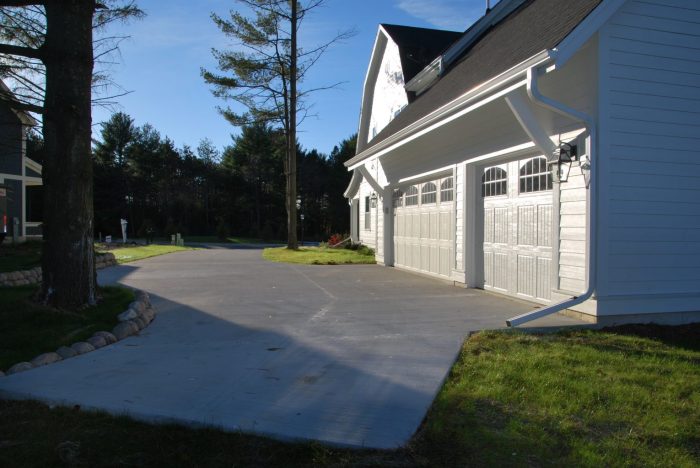
Source: willowtreelandscapesolutions.com
Building a driveway pathway involves careful planning and execution. The choice of material significantly impacts the construction process, with each material requiring specific techniques and tools. This section details the steps for constructing concrete and paverstone pathways and compares the installation of asphalt and gravel pathways.
Concrete Driveway Pathway Construction
Constructing a concrete driveway involves several key steps. First, you’ll need to excavate the area to the desired depth, typically around 6 inches, allowing for a compacted base layer. This base, usually composed of crushed stone or gravel, provides stability and drainage. Next, create a formwork using wood planks to define the pathway’s edges and ensure a level surface. After compacting the base, install rebar mesh for reinforcement, preventing cracking. Then, pour the concrete mix into the formwork, ensuring it’s evenly distributed. Finally, level the surface using a screed, and finish with a bull float for a smooth texture. Allow ample time for curing, typically several days, before removing the formwork. Proper curing is crucial for strength and durability.
Paver Stone Driveway Pathway Installation
Installing paver stones offers a visually appealing and durable option. Begin by preparing the base, similar to concrete installation, excavating and compacting a gravel base. Next, lay down a layer of landscape fabric to prevent weed growth and stabilize the base. Then, install edging to contain the pavers and create a neat boundary. Start laying the pavers, ensuring they are level and evenly spaced. Use a rubber mallet to gently tap them into place. Add polymeric sand in the gaps between the pavers to lock them together and prevent weed growth. Finally, sweep away excess sand, leaving a clean and finished surface. Regular maintenance, such as occasional sweeping and occasional re-application of polymeric sand, will maintain the driveway’s appearance and function.
Asphalt and Gravel Driveway Pathway Installation Comparison
The installation methods for asphalt and gravel driveways differ significantly in terms of complexity and equipment required.
| Asphalt Installation | Gravel Installation |
|---|---|
| Requires specialized equipment, such as an asphalt paver and roller, for proper compaction and a smooth finish. Significant preparation is needed, including excavation and the creation of a well-compacted base. The asphalt itself needs to be heated and laid quickly before it cools. | Relatively simple installation, requiring less specialized equipment. Excavation and base preparation are still necessary, but less precise than for asphalt. Gravel is simply spread and graded to the desired thickness and slope. Compaction is usually achieved using a plate compactor. |
| Higher initial cost due to equipment rental or hiring and the cost of the asphalt itself. The process is typically faster for larger areas. | Lower initial cost, making it a more budget-friendly option. Installation can be completed by hand for smaller areas, minimizing labor costs. However, larger areas may still benefit from using equipment. |
| Provides a smooth, durable, and relatively low-maintenance surface, ideal for high-traffic areas. | Offers a more permeable surface, allowing for better water drainage, which can be advantageous in areas with heavy rainfall. However, it requires more frequent maintenance to prevent shifting and erosion. |
Driveway Pathway Maintenance and Repair: Driveway Pathways
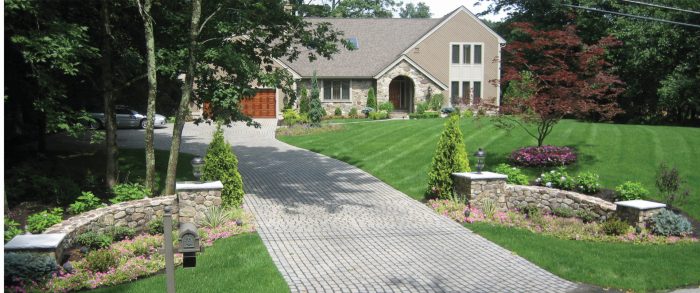
Source: 4designworks.com
Keeping your driveway pathway looking its best and extending its lifespan requires regular maintenance and prompt repairs. Ignoring small problems can lead to larger, more costly issues down the line. This section covers common problems, preventative measures, and repair techniques for different driveway materials.
Common Problems with Driveway Pathway Materials
Different materials present unique challenges. Concrete, for example, is susceptible to cracking due to temperature fluctuations, settling foundations, or heavy loads. Asphalt, while more flexible, can develop potholes from water damage and freeze-thaw cycles. Brick and paver pathways can experience settling, shifting, and weed growth between the stones. Gravel pathways require regular replenishment due to compaction and washout.
Preventative Maintenance Techniques
Regular cleaning is crucial for all driveway types. Sweeping or blowing away debris prevents accumulation that can lead to damage or weed growth. For concrete and asphalt, sealing every few years helps protect against water damage and UV degradation. Sealing creates a protective barrier that resists cracking and discoloration. For brick and paver pathways, regularly inspect for shifting stones and re-level as needed. Resealing the joints between pavers will also help prevent weed growth. Gravel pathways benefit from periodic raking to redistribute the stones and prevent compaction. Addressing minor issues promptly, like small cracks or loose stones, prevents them from becoming major problems.
Concrete Driveway Repair Methods
Cracks in concrete driveways can be repaired using various methods depending on their size and severity. Small cracks can often be filled with a high-quality crack filler, ensuring proper cleaning and preparation of the crack before application. Larger cracks might require sawing out the damaged section and replacing it with new concrete, ensuring a smooth transition with the existing surface. Potholes typically require more extensive repairs, often involving removing the damaged area, adding a suitable base material, and pouring new concrete to restore the driveway’s integrity. Proper curing is essential for the new concrete to achieve its full strength and durability. For example, a 1-inch crack might only need filling, while a 2-inch wide crack might require a section replacement.
Asphalt Driveway Repair Methods
Repairing asphalt driveways often involves filling potholes and patching cracks. Potholes should be cleaned thoroughly, and loose material removed before filling with asphalt patching compound. This compound should be compacted firmly to ensure a smooth surface. Cracks can be sealed using crack filler, similar to concrete repair. For larger repairs, a cold patch or hot mix asphalt may be needed, depending on the size and severity of the damage. The asphalt should be properly compacted to prevent future issues. For instance, a small pothole might be filled with ca old patch of asphalt, while a larger one might require a hot mix asphalt application.
Driveway Pathway Costs and Budgeting
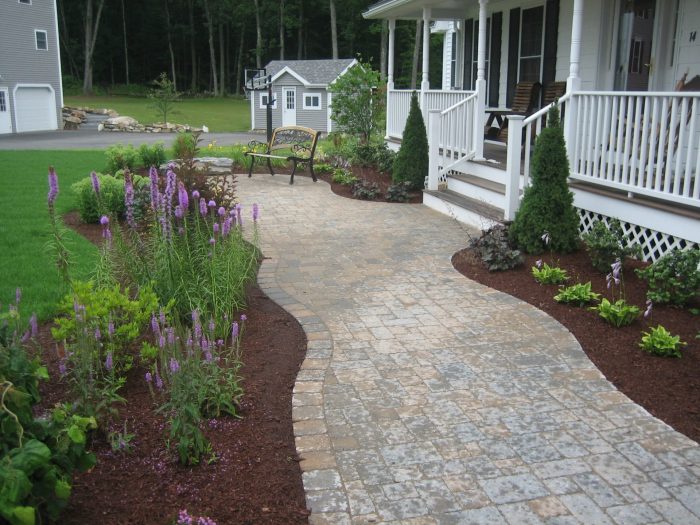
Source: 4designworks.com
Planning a new driveway pathway involves more than just choosing a material; understanding the associated costs is crucial for staying within budget. This section will break down the expenses involved, helping you create a realistic budget for your project. We’ll explore material costs, labor fees, and other factors influencing the final price.
Material and Labor Cost Estimates for Various Driveway Pathways
The cost of building a driveway pathway varies significantly depending on the chosen material and the size of the area. Asphalt, for example, is typically a less expensive option upfront compared to pavers or concrete, but its lifespan and maintenance requirements can impact long-term costs. Labor costs are also a major factor and depend on the complexity of the project, the location (labor rates vary geographically), and the contractor’s experience.
Driveway Pathway Material Cost Comparison
The following table provides estimated costs for materials and labor for a standard 100-square-foot driveway pathway. These are average figures and can fluctuate based on location, material quality, and market conditions. Remember to always obtain multiple quotes from reputable contractors for your specific project.
| Material | Material Cost (USD) | Labor Cost (USD) | Total Estimated Cost (USD) |
|---|---|---|---|
| Asphalt | 500-800 | 800-1200 | 1300-2000 |
| Concrete | 800-1200 | 1000-1500 | 1800-2700 |
| Pavers (Brick/Stone) | 1200-2000 | 1500-2500 | 2700-4500 |
| Gravel | 200-400 | 300-500 | 500-900 |
Factors Influencing Driveway Pathway Project Costs
Several factors beyond material and labor contribute to the overall cost. These include site preparation (clearing, grading, excavation), permits and inspections (required in many areas), and any unforeseen complications during construction. For example, if significant excavation is required to achieve a proper grade, or if unexpected underground utilities are encountered, costs can escalate quickly. The complexity of the design, such as curves or intricate patterns, will also impact both material and labor costs. Finally, the geographic location significantly impacts both material and labor costs. Materials may be more expensive in certain areas, and labor rates vary considerably across regions. Consider obtaining multiple quotes to ensure you’re getting a competitive price.
Driveway Pathway Lighting and Safety
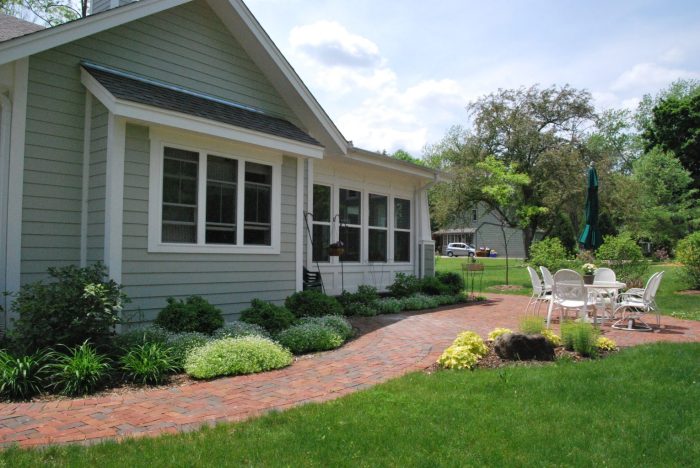
Source: willowtreelandscapesolutions.com
A well-lit driveway pathway is more than just aesthetically pleasing; it’s a crucial element of home security and safety, significantly reducing the risk of accidents and injuries, especially at night. Proper lighting enhances visibility, making it easier for everyone – from family members to guests – to navigate the pathway safely, regardless of weather conditions or limited vision. This section will explore lighting design schemes, essential safety features, and the importance of universal accessibility.
Driveway Pathway Lighting Design Schemes, Driveway pathways
Effective lighting design for driveway pathways balances safety and aesthetics. A poorly designed system can be ineffective, overly bright, or even create hazardous glare. The goal is to provide sufficient illumination without being intrusive or overwhelming.
- Low-level path lighting: This approach uses small, low-intensity lights spaced evenly along the pathway. These lights might be solar-powered path lights, bollard lights, or even strategically placed landscape lighting. The gentle illumination guides users along the path without causing harsh shadows or glare.
- Accent lighting: Accent lighting highlights architectural features or landscaping elements along the driveway. This not only adds visual appeal but also subtly illuminates the pathway, providing additional safety. For example, uplighting a retaining wall or highlighting a garden bed can indirectly illuminate the path.
- Motion-sensor lighting: Motion-sensor lights offer a practical and energy-efficient solution. They activate only when motion is detected, illuminating the pathway only when needed. This is particularly useful for deterring intruders and conserving energy.
- Area lighting: Area lighting provides broader illumination, often using higher-intensity fixtures. This approach is suitable for larger driveways or areas with multiple access points. However, it’s crucial to avoid excessive brightness or glare that could impair vision.
Driveway Pathway Safety Features
Beyond lighting, several safety features can significantly reduce the risk of accidents on driveway pathways. These features work in conjunction with lighting to create a safer environment.
- Non-slip surfaces: Choosing non-slip materials for the pathway itself is crucial, especially in areas prone to ice or rain. Materials like textured concrete or paving stones offer better traction than smooth surfaces.
- Handrails and railings: For pathways with inclines or changes in elevation, handrails or railings provide added stability and support, preventing falls, particularly beneficial for elderly individuals or those with mobility challenges.
- Clear signage and markings: Clear signage can indicate changes in direction, warn of potential hazards, or guide users to specific destinations. Reflective markers or paint can enhance visibility at night.
- Proper drainage: Adequate drainage prevents water from accumulating on the pathway, reducing the risk of slips and falls. This includes proper grading and the installation of drainage systems.
Driveway Pathway Visibility and Accessibility
Ensuring proper visibility and accessibility for all users is paramount. This means designing a pathway that is safe and usable for people of all ages and abilities.
Consider the needs of individuals with visual impairments, mobility limitations, or other disabilities. Features like tactile paving, audible warnings, and sufficient space for wheelchairs or other mobility devices should be integrated into the design. Well-placed lighting and contrasting colors can also improve visibility for people with low vision. For example, a brightly colored handrail against a darker background provides better contrast and visibility.
Driveway Pathway and Environmental Impact
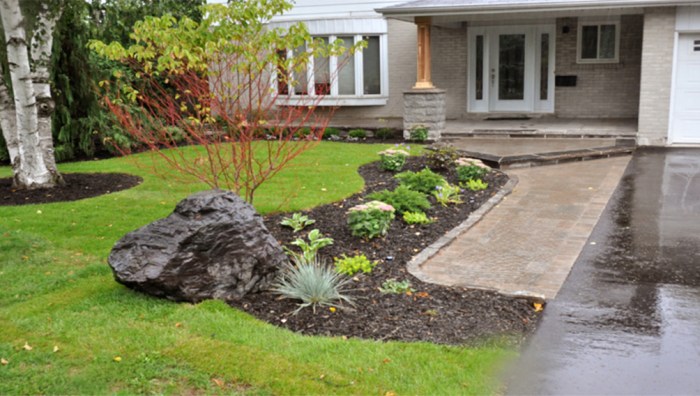
Source: colourlandscaping.com
Choosing driveway materials has a significant impact on the environment, from resource extraction and manufacturing to long-term maintenance and eventual disposal. Understanding these impacts allows for more informed decisions that minimize environmental harm. This section explores the environmental consequences of various driveway materials and highlights sustainable alternatives.
Different driveway materials possess varying environmental footprints. Asphalt, for example, relies heavily on petroleum, a non-renewable resource, contributing to greenhouse gas emissions during its production and use. Concrete, while durable, requires significant energy for its manufacture and involves the extraction of raw materials like cement and aggregates, often leading to habitat disruption and dust pollution. Conversely, permeable paving materials like gravel or porous concrete allow for better water infiltration, reducing runoff and mitigating potential flooding. Natural materials such as brick or stone have varying impacts depending on their origin and processing; locally sourced materials generally have a smaller carbon footprint than those transported long distances.
Environmental Impacts of Common Driveway Materials
The following table summarizes the environmental impacts of several common driveway materials. It’s important to note that these impacts can vary depending on factors such as material sourcing, manufacturing processes, and transportation distances.
| Material | Environmental Impact |
|---|---|
| Asphalt | High carbon footprint due to petroleum dependence; contributes to air and water pollution during production and maintenance. |
| Concrete | High embodied energy; significant CO2 emissions during cement production; potential for habitat disruption during aggregate extraction. |
| Gravel | Relatively low environmental impact, but the potential for dust pollution and runoff if not properly installed. |
| Brick | Environmental impact varies greatly depending on the manufacturing process and sourcing of clay; potential for air pollution during firing. |
| Stone (e.g., pavers) | Environmental impact depends on the type of stone and its origin; quarrying can cause habitat damage and dust pollution. |
| Recycled Materials (e.g., recycled asphalt, plastic lumber) | Lower environmental impact compared to virgin materials; reduces landfill waste and conserves resources. |
Sustainable and Eco-Friendly Driveway Pathway Options
Several sustainable options minimize the environmental impact of driveway construction. These options often prioritize the use of recycled materials, locally sourced materials, and permeable paving systems.
- Permeable Paving: This allows rainwater to infiltrate the ground, reducing runoff and replenishing groundwater supplies. Examples include porous concrete, permeable interlocking concrete pavers, and gravel.
- Recycled Materials: Utilizing recycled asphalt, plastic lumber, or recycled rubber in driveway construction reduces landfill waste and conserves resources. Recycled asphalt, for instance, can be used in the creation of new asphalt surfaces.
- Locally Sourced Materials: Choosing materials sourced from nearby quarries or suppliers reduces transportation costs and emissions associated with long-distance shipping. This is particularly beneficial for materials like stone or brick.
- Plantings: Integrating vegetation into the driveway design, such as planting grass between pavers or using green infrastructure techniques, can help mitigate the “heat island effect” and improve air quality.
Selecting Materials with Minimal Environmental Footprint
Selecting environmentally friendly driveway materials requires careful consideration of several factors. A life-cycle assessment, considering the entire environmental impact from extraction to disposal, should ideally be performed.
- Assess Material Sources: Investigate the origin of materials and prioritize those with minimal transportation distances and sustainable extraction practices.
- Consider Embodied Energy: Evaluate the energy required for material production and transportation. Lower embodied energy materials generally have a smaller carbon footprint.
- Evaluate Material Durability: Choosing durable materials reduces the need for frequent replacements, minimizing the overall environmental impact over the driveway’s lifespan.
- Explore Recycling Options: Investigate whether the chosen material can be recycled at the end of its life cycle. This reduces waste sent to landfills.
- Consult with Professionals: Seek advice from landscape architects or contractors specializing in sustainable construction practices to ensure informed decision-making.
Wrap-Up
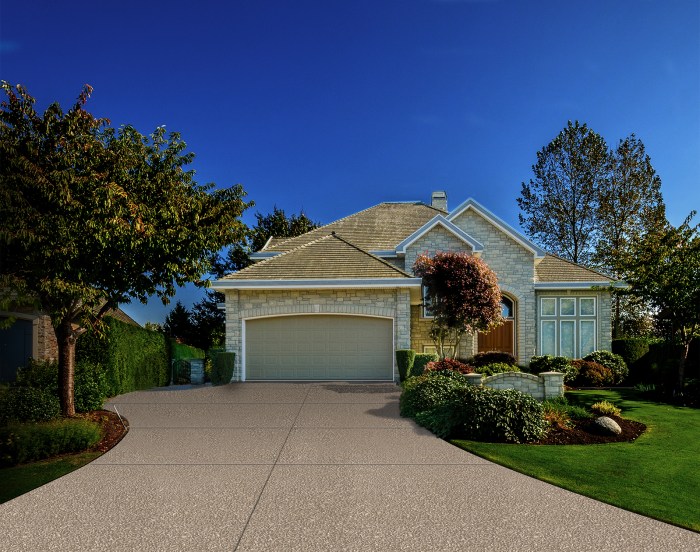
Source: arteviaplacing.com
Creating the perfect driveway pathway is a blend of art and science, balancing aesthetics with practicality. By carefully considering the factors discussed—from material selection and design to construction and maintenance—you can transform your driveway into a functional and visually appealing extension of your home. Remember to prioritize safety features and consider the environmental impact of your chosen materials. With a little planning and the right approach, your driveway pathway will be a source of pride and enjoyment for years to come. Now, get started on designing your dream driveway!
